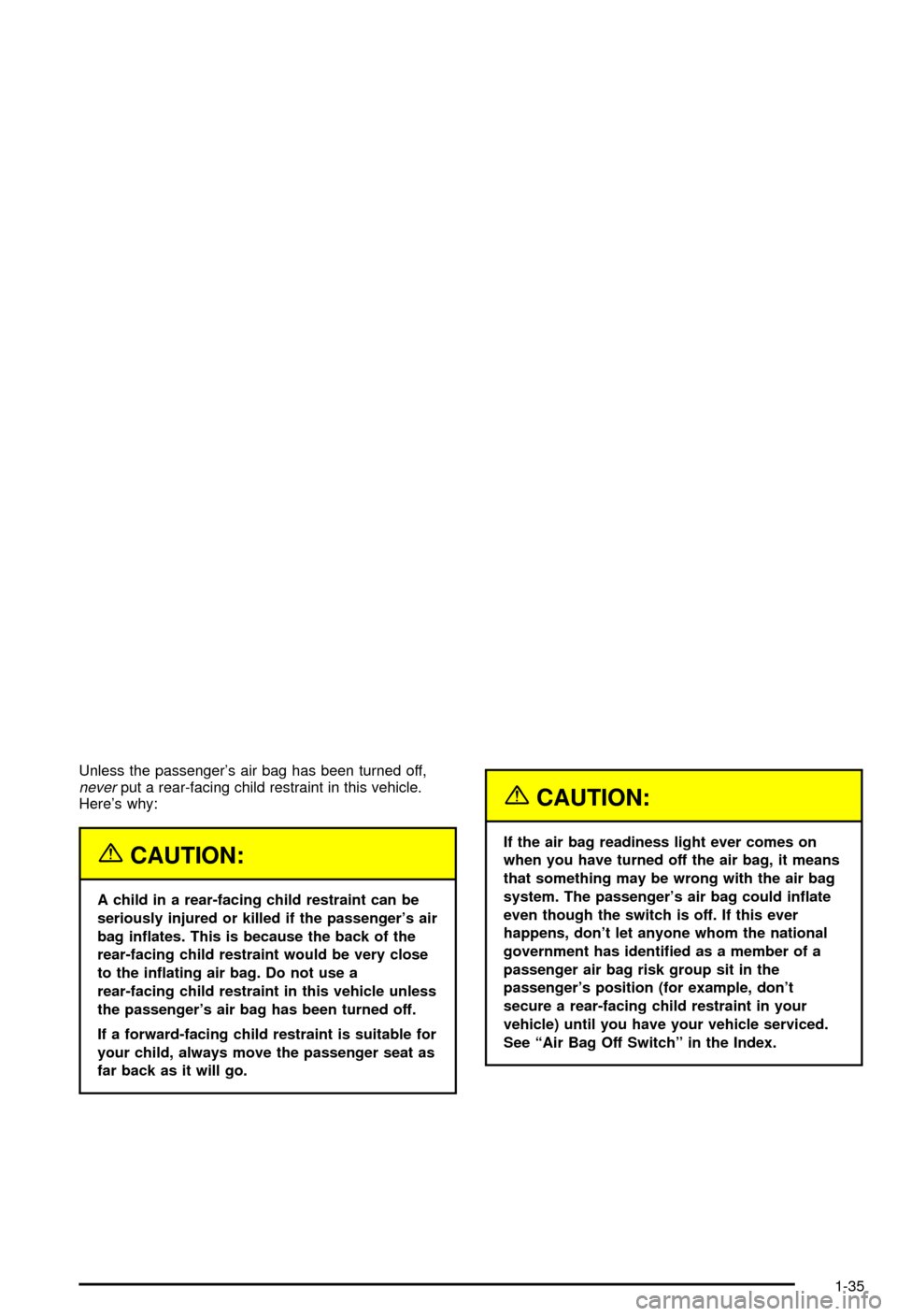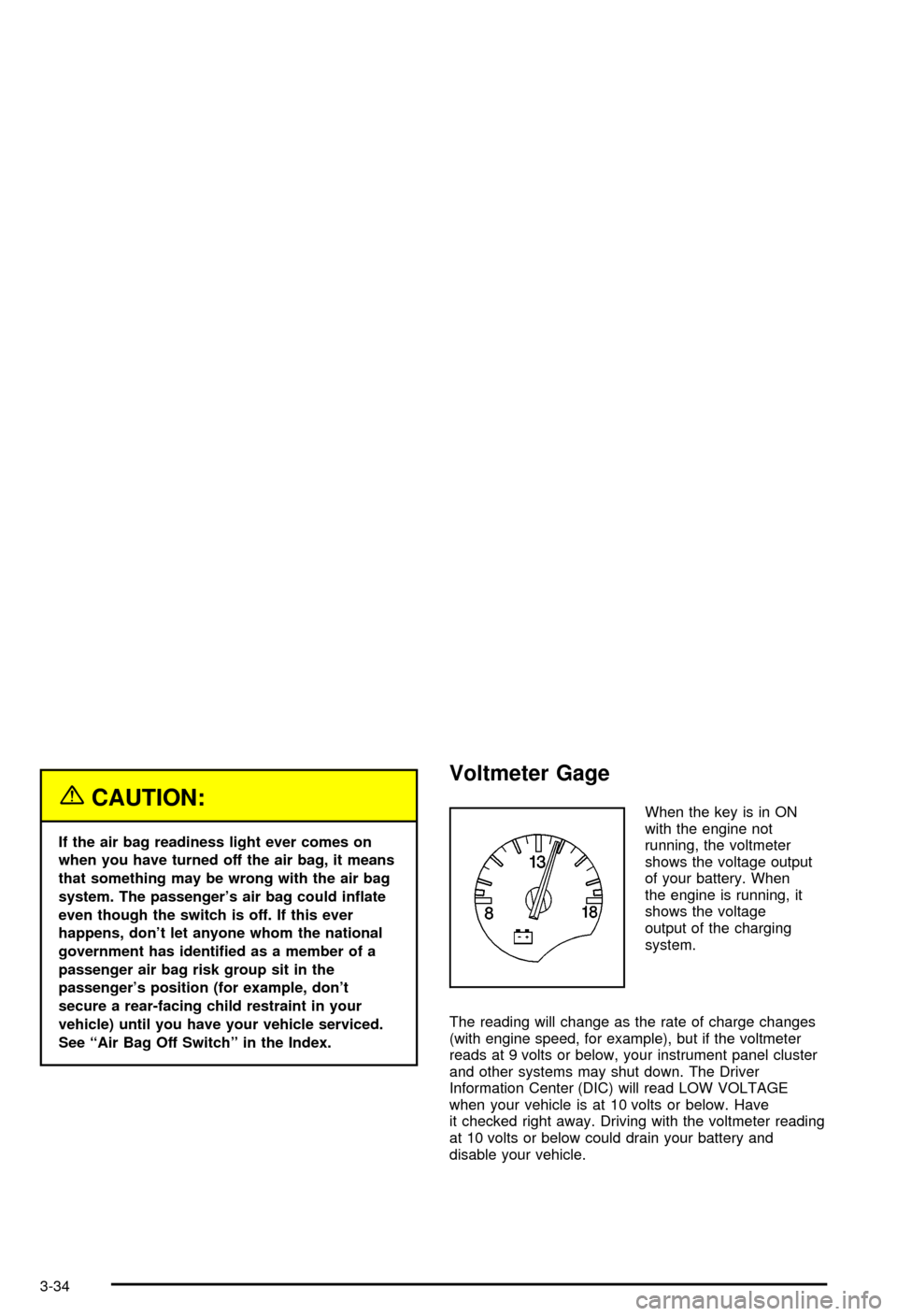Page 40 of 368
Securing a Child Restraint in the
Passenger Seat Position
Your vehicle has a passenger air bag. There's an air
bag off switch in the glove box you can use to turn
off the passenger's air bag when you want to secure a
rear-facing child restraint at the passenger's position.
See
Air Bag Off Switch on page 1-44for more on this,
including important safety information.
1-34
Page 41 of 368

Unless the passenger's air bag has been turned off,neverput a rear-facing child restraint in this vehicle.
Here's why:
{CAUTION:
A child in a rear-facing child restraint can be
seriously injured or killed if the passenger's air
bag in¯ates. This is because the back of the
rear-facing child restraint would be very close
to the in¯ating air bag. Do not use a
rear-facing child restraint in this vehicle unless
the passenger's air bag has been turned off.
If a forward-facing child restraint is suitable for
your child, always move the passenger seat as
far back as it will go.
{CAUTION:
If the air bag readiness light ever comes on
when you have turned off the air bag, it means
that something may be wrong with the air bag
system. The passenger's air bag could in¯ate
even though the switch is off. If this ever
happens, don't let anyone whom the national
government has identi®ed as a member of a
passenger air bag risk group sit in the
passenger's position (for example, don't
secure a rear-facing child restraint in your
vehicle) until you have your vehicle serviced.
See ªAir Bag Off Switchº in the Index.
1-35
Page 42 of 368
You'll be using the lap-shoulder belt. SeeTop Strap on
page 1-30if the child restraint has one. Be sure to
follow the instructions that came with the child restraint.
Secure the child in the child restraint when and as
the instructions say.
1. Your vehicle has a passenger's air bag. If you are
using a rear-facing child restraint in this seat, make
sure the air bag is turned off. See
Air Bag Off
Switch on page 1-44. If your child restraint is
forward-facing, always move the seat as far back
as it will go before securing it in this seat. See
Manual Seats on page 1-2orPower Seats
on page 1-2.
2. Put the restraint on the seat.
3. Pick up the latch plate, and run the lap and shoulder
portions of the vehicle's safety belt through or
around the restraint. The child restraint instructions
will show you how.
4. Buckle the belt. Make sure the release button is
positioned so you would be able to unbuckle the
safety belt quickly if you ever had to.
1-36
Page 43 of 368
5. Pull the rest of the lap belt all the way out of the
retractor to set the lock.6. To tighten the belt, feed the lap belt back into the
retractor while you push down on the child restraint.
You may ®nd it helpful to use your knee to push
down on the child restraint as you tighten the belt.
7. Push and pull the child restraint in different
directions to be sure it is secure.
1-37
Page 44 of 368
To remove the child restraint, just unbuckle the vehicle's
safety belt and let it go back all the way. The safety
belt will move freely again and be ready to work for an
adult or larger child passenger.
If you were using a rear-facing child restraint, turn on
the passenger's air bag when you remove the
rear-facing child restraint from the vehicle unless the
person who will be sitting there is a member of a
passenger air bag risk group. See
Air Bag Off Switch on
page 1-44.
{CAUTION:
If the passenger's air bag is turned off for a
person who isn't in a risk group identi®ed by
the national government, that person won't
have the extra protection of an air bag. In a
crash, the air bag wouldn't be able to in¯ate
and help protect the person sitting there. Don't
turn off the passenger's air bag unless the
person sitting there is in a risk group. See ªAir
Bag Off Switchº in the Index for more on this,
including important safety information.
1-38
Page 46 of 368
{CAUTION:
Anyone who is up against, or very close to,
any air bag when it in¯ates can be seriously
injured or killed. Air bags plus lap-shoulder
belts offer the best protection for adults, but
not for young children and infants. Neither the
vehicle's safety belt system nor its air bag
system is designed for them. Young children
and infants need the protection that a child
restraint system can provide. Always secure
children properly in your vehicle. To read how,
see
Older Children on page 1-21andInfants
and Young Children on page 1-23
.
There is a air bag
readiness light on the
instrument panel, which
shows the air bag symbol.The system checks the air bag electrical system for
malfunctions. The light tells you if there is an electrical
problem. See
Air Bag Readiness Light on page 3-32for more information.
Where Are the Air Bags?
The driver's air bag is in the middle of the
steering wheel.
1-40
Page 146 of 368

{CAUTION:
If the air bag readiness light ever comes on
when you have turned off the air bag, it means
that something may be wrong with the air bag
system. The passenger's air bag could in¯ate
even though the switch is off. If this ever
happens, don't let anyone whom the national
government has identi®ed as a member of a
passenger air bag risk group sit in the
passenger's position (for example, don't
secure a rear-facing child restraint in your
vehicle) until you have your vehicle serviced.
See ªAir Bag Off Switchº in the Index.
Voltmeter Gage
When the key is in ON
with the engine not
running, the voltmeter
shows the voltage output
of your battery. When
the engine is running, it
shows the voltage
output of the charging
system.
The reading will change as the rate of charge changes
(with engine speed, for example), but if the voltmeter
reads at 9 volts or below, your instrument panel cluster
and other systems may shut down. The Driver
Information Center (DIC) will read LOW VOLTAGE
when your vehicle is at 10 volts or below. Have
it checked right away. Driving with the voltmeter reading
at 10 volts or below could drain your battery and
disable your vehicle.
3-34
Page 227 of 368
{CAUTION:
Things you put inside your vehicle can strike
and injure people in a sudden stop or turn, or
in a crash.
·Put things in the rear area of your vehicle.
Try to spread the weight evenly.
·Never stack heavier things, like suitcases,
inside the vehicle so that some of them
are above the tops of the seats.
·Don't leave an unsecured child restraint in
your vehicle.
·When you carry something inside the
vehicle, secure it whenever you can.
Towing a Trailer
Your Corvette is neither designed nor intended to tow a
trailer.
4-35